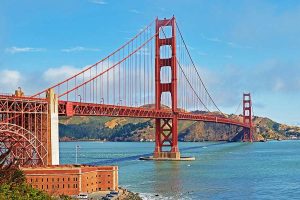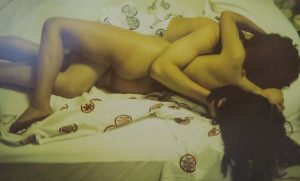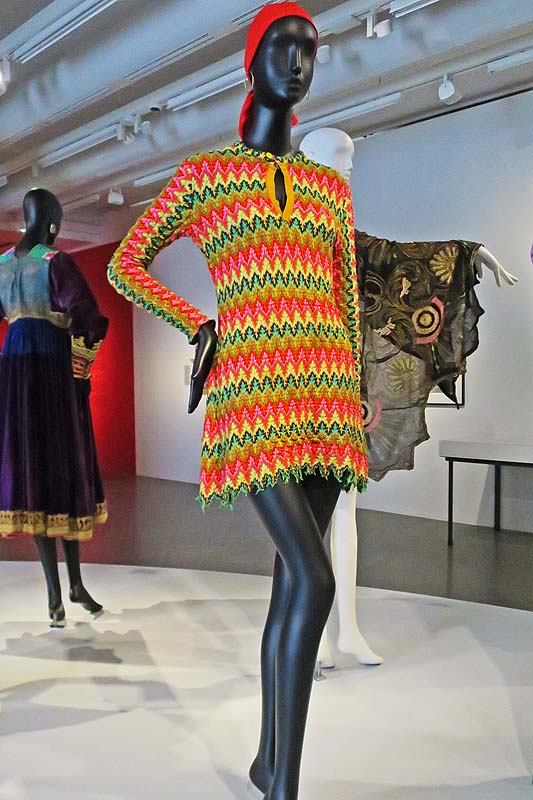Summer of Love im Palais Populaire
Von Holger Jacobs
26.06.2019
Eine Ausstellung über den Höhepunkt der Hippie Bewegung 1967 in San Francisco
Die 60er Jahre in der zweiten Hälfte des vergangenen Jahrhunderts waren so prall gefüllt mit neuen gesellschaftlichen Bewegungen, politischen Umwälzungen und künstlerischen Erneuerungen, dass es schwer fällt aus diesen vielen Themen einen Schwerpunkt herauszugreifen, der stellvertretend sein könnte für eine Beschreibung der damaligen Situation und Stimmung in der westlichen Welt.
Doch wie kann man die enormen Veränderungen zusammenfassen, die sich speziell von 1965 -69 ereigneten?
Der Kurator und Kunsthistoriker Max Hollein hatte eine Idee:
Als der Österreicher Max Hollein 2016 Direktor des Fine Arts Museum of San Francisco wurde kam ihm sofort der Gedanke, einen besonderen Aspekt dieser Stadt herauszustellen:
Die Hippie und Flower Power Bewegung Ende der 60er Jahre an der Westküste der USA, die letztlich viel mehr war, als nur Blumenkinder und zugekiffte Rock n‘ Roller – sie war der Höhepunkt einer gesellschaftlichen Umwälzung, die bis heute nachwirkt!
Die gesellschaftliche Situation in der Nachkriegszeit.
Nach dem 2. Weltkrieg waren die Menschen in Europa gefangen von den Nachwehen des entsetzlichsten Krieges, den die Menschheit je erlebt hatte. Erstes Ziel nach dem Krieg war es also zu überleben und sich wiederaufzubauen.
Das Zwischenmenschliche blieb auf der Stecke. Werte und Moralvorstellungen wurden aus der Zeit vor dem Krieg übernommen.
Kindererziehung und Bildung, Stellung der Frau und Patriachat entsprachen der Gesellschaft aus dem Beginn des 20. Jahrhunderts (ein guter Anschauungsunterricht zu der Situation in den 50er Jahren findet sich in der Fernsehserie „Ku’damm 56“).
Doch eine Jugend, die erst kurz vorher, im oder nach dem Krieg geboren worden war, wollte sich damit nicht abfinden.
Für sie hatte ein neues Zeitalter begonnen, wozu andere Einstellungen zu Eltern, Religion, Bildung, Kunst, Musik und Sex gehörten.
Besonders das Verhältnis der Eltern zu ihren Kindern, der Umgang der Lehrer mit ihren Schülern und letztlich auch das Miteinander von Mann und Frau musste sich komplett ändern.
Autoritäten wurden in Frage gestellt, die Moralvorstellungen der Kirche über den Haufen gekippt und Liebe und Sex war plötzlich Dank der Pille immer, überall und mit jedem möglich.
Zurück zum „SUMMER OF LOVE“ 1967 in San Francisco.
Ähnlich wie in Europa, hatte auch in den USA eine Gegenbewegung der Jugend zum religiös-konservativem Denken der Eltern begonnen.
Hinzu kam der grausame Krieg der Amerikaner in Vietnam, der letztlich völlig sinnlos 1,8 Millionen Vietnamesen das Leben gekostet hat und ein ganzes Land verwüstet zurückließ.
Tausende Jugendlich gingen dagegen auf die Strasse und mischten sich mit den Protesten gegen Rassendiskriminierung und Ungerechtigkeiten der Staatsmacht.
Am 24. April 1967 verweigerte der berühmte Boxweltmeister Muhammad Ali in einer öffentlichen Ansprache den Kriegsdienst in Vietnam, weswegen er zu 5 Jahren Gefängnis verurteilt wurde.

6 photos: „Keep the idea of freedom alive“, 1964, „SUMMER OF LOVE“ © Fine Art Museum of San Francisco
Warum San Francisco?
San Francisco hatte nach seinem furchtbaren Erdbeben 1906, bei dem ca. 3/4 der Stadt zerstört wurde, einen wahren Boom erlebt, der in einer Weltausstellung 1939 auf Treasure Island mündete.
In den 50er- und 60er Jahren wurde die Berkeley University of California durch progressive Autoren, wie Timothy Leary, Phil K. Dick und Robert Anton Wilson zur Schmiede neuen Denkens. Diese zogen weitere Intellektuelle, wie Alan Ginsberg, Timothy Leary und Alan Watts an.
Am 4. April 1967 hielt der Anführer der afro-amerikanischen Minderheit in den USA, Dr. Martin Luther King, seine berühmte Rede auf dem Campus der Berkley University.
Zu den fortschrittlichen Autoren und Professoren gesellten sich bald auch Musiker und Bands wie GREATFUL DEAD, SANTANA, JEFFERSON AIRPLANE, JANIS JOPLIN und STEPPENWOLF.
Künstler malten fantasievolle Poster zu den Rockkonzerten.
Als der Sänger Scott McKenzie sein berühmtes Lied „San Francisco (Be sure to wear some flowers in your hair)“ am 13. Mai 1967 veröffentlichte, war auch noch eine Hymne für die gesamte Flower-Power-Bewegung gefunden.
Im Jahre 1967 strömten Hundertausende von jungen Menschen nach San Francisco, wobei sie meistens im billigen Wohnviertel Haight-Ashbury oder einfach in Zelten im Golden Gate Park landeten.
Drogen, Musik und heitere Stimmung führten zu einem neuen Lebensgefühl, welches sich für ein paar Jahre über die gesamte westliche Hemisphäre ausbreitete – ein Mythos war geboren.
Die Ausstellung „Summer of Love – art, fashion and rock n‘ roll“ wurde vom Fine Arts Museum of San Francisco übernommen und zeigt 150 Teile aus unterschiedlichen Disziplinen.
Angefangen von 25 original Kleidungsstücken aus dieser Zeit, über Plattencover, Poster, Bücher und Fotografien. Im Untergeschoss läuft ein Video mit psychedelischen Bildern von Bill Ham.
Epilog
Sieht man einmal auf die Bilanz, was langfristig die Jugendbewegung der 60er Jahre gebracht hat, sieht das Ergebnis ernüchternd aus.
Sinnlose Kriege mit Tausenden von Toten gibt es nach wie vor, wie den Irakkrieg 2003, der ca. 150.000 Iraki das Leben kostete, obwohl es keinen Grund zum Überfall auf das Land gab. Aus dem Chaos nach dem Irakkrieg ging die Terrororganisation IS (oder ISIS) hervor, die noch einmal Tausenden Menschen das Leben kostete.
Die völlige Gleichberechtigung der Frauen ist bis heute nicht verwirklicht (siehe #MeToo) und die Rassendiskriminierung in den USA gibt es immer noch.
Auch die sexuelle Befreiung ist nur nur teilweise vollzogen. Amerika ist nach wie vor ein zutiefst konservativ-religiöses Land, wie man mit der Wahl von Donald Trump gesehen hat. Auf diesem Gebiet ist eher ein Rückschritt zu verzeichnen.
Und Europa? Auch hier ist der Konservatismus bis zum Nationalismus wieder auf dem Vormarsch. Haben die Menschen aus der Geschichte den gar nichts gelernt?
„Summer of Love“
Vom 20.6 – 28.10.2019
Palais Populaire
Unter den Linden 5
10117 Berlin
Mi – Mo 11 – 18 Uhr, Do – 21 Uhr
Hier unsere Bilderserie mit 10 Fotos von original Outfits aus diesen Jahren:
english text
(pictures above)
Summer of Love at the Palais Populaire in Berlin
By Holger Jacobs
06/26/2019
An exhibition about the peak of the hippie movement in San Francisco in 1967
The 1960s, in the second half of the last century, were so full of new social movements, political upheavals and artistic renewal that it is difficult to pick out a focus on these many topics that could be representative of a description of the situation and sentiment at that time in the western world.
But how can one summarize the enormous changes that occurred especially from 1965-69?
The curator and art historian Max Hollein had an idea:
When Austrian born Max Hollein became director of the Fine Arts Museum of San Francisco in 2016, he immediately came up with the idea of highlighting a special aspect of the city: the hippie and flower power movement of the late 1960s on the West Coast of the United States, which was much more than just girls with flowers in their hair and cuddly Rock n ‚Roller – it was the culmination of a social upheaval that continues until today!
The social situation in the postwar period.
After World War II, people in Europe were trapped by the aftermath of the most horrific war humanity has ever experienced.
The first goal after the war was to survive and rebuild. But the relationships between men and women remained very conservative. Values and moral concepts were still adopted from before the war. Parenting and education, the role of women and the patriarchy corresponded to the society from the beginning of the 20th century (a good visual instruction can be found in the television series „Ku’damm 56“).
But a youth who had been born shortly before, during or after the war did not want to accept it. For them, a new era had begun, which included other attitudes toward parents, religion, education, art, music, and sex.
Especially the relationship between the parents and their children, the way the teachers interacted with their students, and ultimately the relationship between husband and wife had to change completely.
Authorities were called into question, the moral concept of the church was upset and love and sex was suddenly (thanks to the pill) always, everywhere and with everyone possible.
Back to „SUMMER OF LOVE“ 1967 in San Francisco.
Similar to Europe, a counter-movement of the youth to the religious-conservative thinking of their parents had begun in the USA as well. Added to this was the cruel war of the Americans in Vietnam, which was in the end completely senselessly and cost the lives of 1.8 million Vietnamese and left a whole country devastated. Thousands of teenagers took to the streets and mingled with protests against racial discrimination and state injustice.
On April 24, 1967, the box champion Muhammad Ali publicly refused to serve in Vietnam, and was sentenced to five years in prison.
Why San Francisco?
San Francisco had experienced a veritable boom after its terrible earthquake in 1906, which destroyed approximately 3/4 of the city, and culminated 1939 in a World’s Fair on Treasure Island. In the 1950s and 1960s, progressive authors such as Timothy Leary, Phil K. Dick, and Robert Anton Wilson turned Berkeley University of California into a forge of new thinking.
These attracted more intellectuals and songwriters, such as Alan Ginsberg, Timothy Leary and Alan Watts.
On April 4, 1967, the leader of the African American minority in the US, Dr. Martin Luther King, hold his famous speech on the campus of Berkley University.
Musicians and bands such as GREATFUL DEAD, SANTANA, JEFFERSON AIRPLANE, JANIS JOPLIN and STEPPENWOLF soon joined the progressive authors and intellectuals.
Artists painted imaginative posters for rock concerts.
When singer Scott McKenzie released his famous song „San Francisco (Be sure to wear some flowers in your hair)“ on May 13, 1967, a hymn was also found for the entire Flower Power movement.
Hundreds of thousands of young people flocked to San Francisco in 1967, mostly landing in the cheap Haight-Ashbury neighborhood or simply camping in Golden Gate Park.
Drugs, music and a cheerful mood led to a new sense of life, which spread over the entire Western Hemisphere for a few years – a myth was born.
The exhibition „Summer of Love – art, fashion and rock n ‚roll“ was taken over by the Fine Arts Museum of San Francisco and shows 150 pieces from different disciplines.
Starting with 25 original garments from this period, covers, posters, books and photographs. In the basement you can see a video with psychedelic images by Bill Ham.
Epilogue
If you look at the result, what the youth movement of the 60s has brought in the long term, the result looks sobering.
There are still senseless wars with thousands of dead, such as the Iraq war of 2003, which cost around 150,000 Iraqi lives, even though there was no reason to invade the country. Out of the chaos after the Iraq war, the terrorist organization IS (or ISIS) emerged, which once again cost the lives of thousands of people.
The full equality of women is still unrealized (see #MeToo) and racial discrimination in the US still exists.
The sexual liberation is only partially completed. America is still a deeply conservative-religious country, as seen by the election of Donald Trump. In this topic, the result is even a step backwards.
And Europe? Here, too, conservatism is on the rise again to nationalism. Had humans learned nothing from history?
„Summer of Love“
20.6 – 28.10.2019
Palais Populaire
Unter den Linden 5
10117 Berlin
Wed – Mo 11am – 6pm, Thu – 9pm
Author: Holger Jacobs
Founder & Editorial Director of kultur24.berlin ug.
Founder & Editorial Director of kultur24 TV on Youtube.
Former correspondent for fashion in Paris.
Photographer, writer and filmmaker.
















